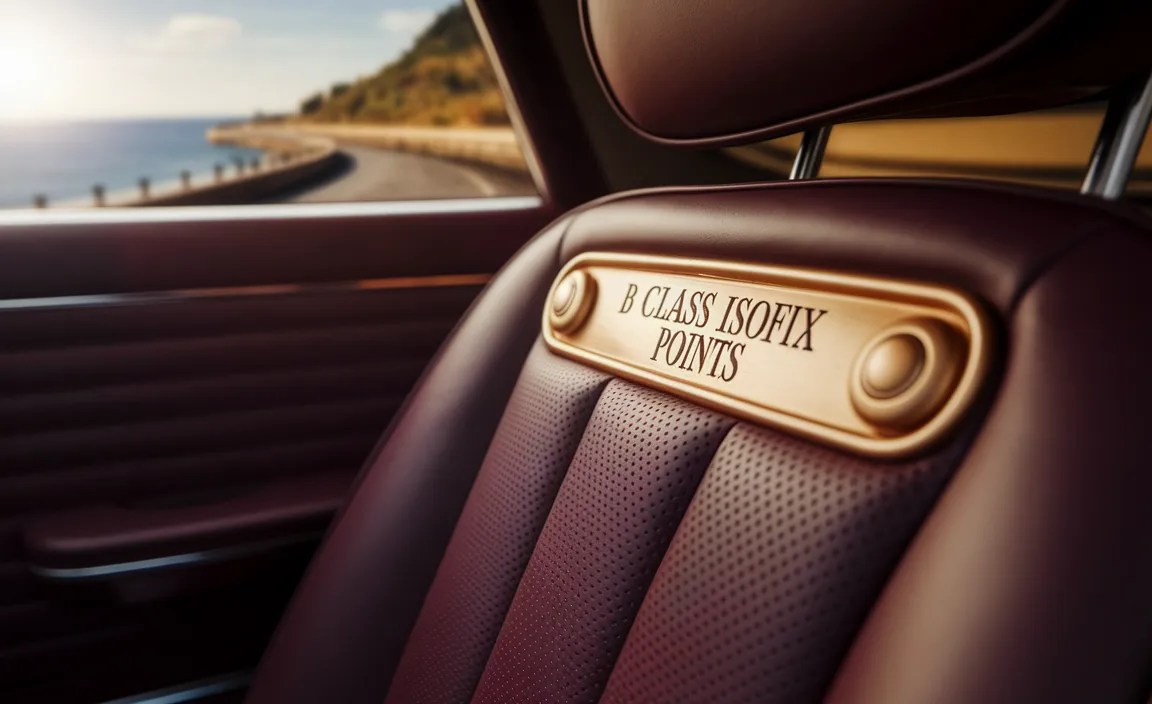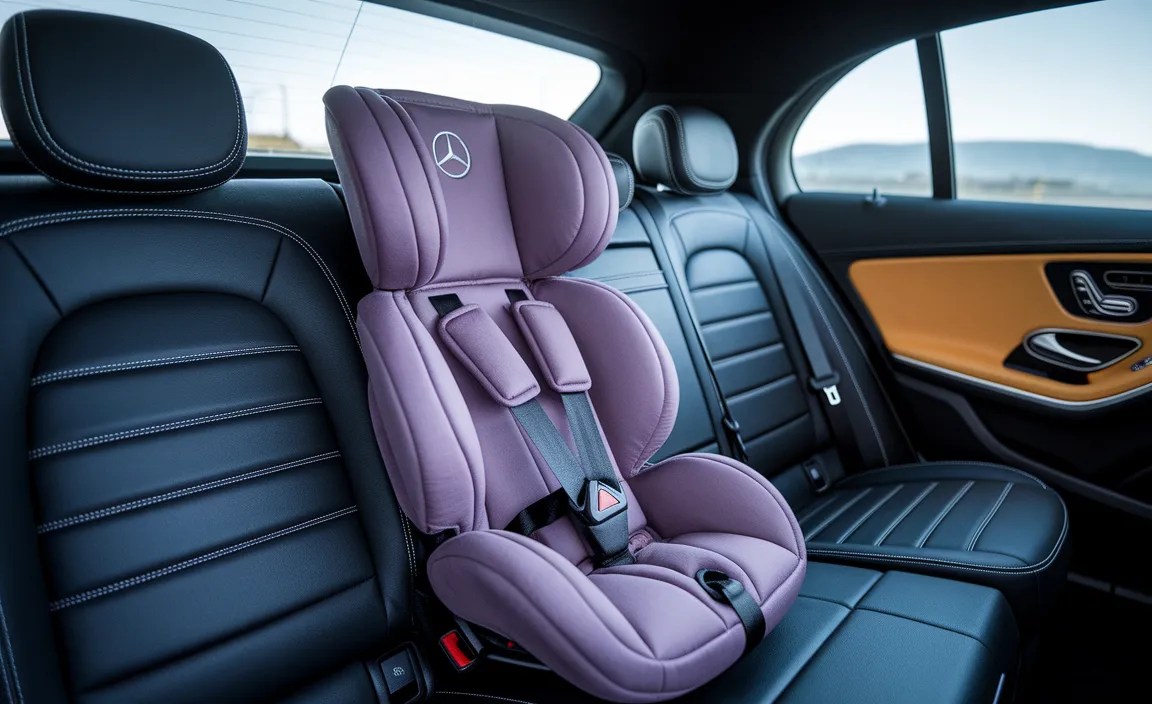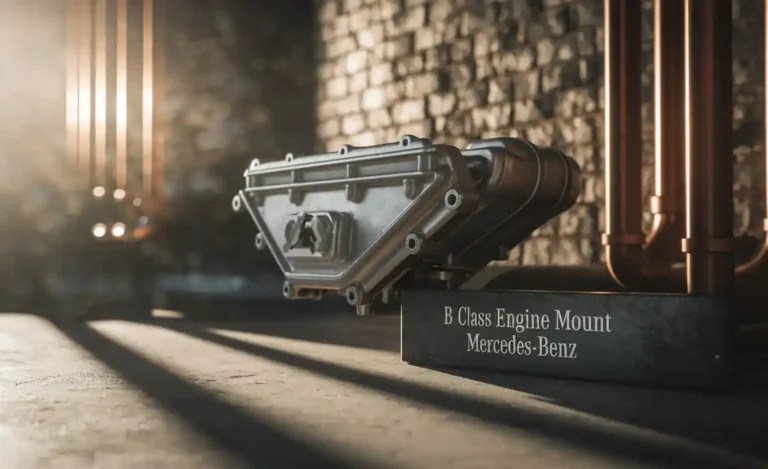B Class ISOFIX Points: Essential Family Luxury
Effortlessly secure your child’s car seat in your Mercedes-Benz B-Class using ISOFIX points. These standardized anchor points drastically simplify installation, enhance safety, and offer peace of mind for families. Discover how this intuitive system transforms your B-Class into the ultimate safe haven for your little ones. Learn about their location, benefits, and proper usage for worry-free journeys.

Traveling with young children transforms a car from a simple mode of transport into a mobile family sanctuary. For parents, safety is paramount, and the Mercedes-Benz B-Class, known for its blend of practicality and luxury, offers a sophisticated solution for child seat installation: ISOFIX points. Many new parents find the process of correctly fitting a child car seat daunting, leading to potential safety risks or unnecessary stress. You might wonder if your B-Class even has these crucial anchors, where they are located, and how to use them effectively. Rest assured, Mercedes-Benz prioritizes family comfort and security, and understanding your car’s ISOFIX system is simpler than you might think. This guide will demystify B-Class ISOFIX points, showing you how easily and securely you can install child seats, ensuring every journey is a safe and comfortable one.
Understanding ISOFIX: A Foundation for Family Safety
ISOFIX, which stands for “International Organization for Standardization FIX,” is a globally recognized standard for child car seat anchorage systems. Its core principle is to provide a simple, secure, and standardized way to attach child safety seats directly to the vehicle’s chassis. Before ISOFIX, parents relied on threading seat belts through car seats, a method prone to errors and variations in tightness. ISOFIX aims to eliminate this guesswork, ensuring consistent and secure installation every time.
The system typically involves two rigid connectors on the child car seat that clip directly onto two loops, or anchor points, located in the vehicle’s seat. Most modern vehicles, including the Mercedes-Benz B-Class, are equipped with these points. Additionally, many ISOFIX systems include a top tether strap or a support leg, which further stabilizes the seat and prevents rotation in case of impact.
Why ISOFIX is a Game-Changer for Parents
The introduction of ISOFIX revolutionized child car seat safety for several key reasons:

- Simplified Installation: Connecting an ISOFIX seat is typically a straightforward “click” mechanism, significantly reducing fitting time and complexity.
- Reduced Risk of Incorrect Fitting: The standardized connectors and clear indicators minimize the chances of the seat being installed loosely or incorrectly, which is a major safety concern with seat belt installations.
- Enhanced Security: ISOFIX anchors attach directly to the car’s frame, creating a more rigid connection that offers superior protection in a collision compared to seat belt installations.
- Universal Compatibility (Mostly): While some variations exist, ISOFIX aims for broad compatibility across different car models and child seat manufacturers.
For families choosing a Mercedes-Benz B-Class, the inclusion of ISOFIX points is a clear indication of the vehicle’s family-friendly design, blending luxury with essential practicalities. It means parents can have greater confidence in their child’s safety, allowing them to focus on enjoying the drive.
Locating ISOFIX Points in Your Mercedes-Benz B-Class
Finding the ISOFIX anchor points in your Mercedes-Benz B-Class is the first step to a secure installation. They are strategically placed to offer the best possible anchorage for child seats. While exact locations can vary slightly between model years and B-Class generations (W246, W247, etc.), the general principle remains the same.
The Standard B-Class ISOFIX Location
In virtually all Mercedes-Benz B-Class models equipped with ISOFIX, you will find the primary lower anchor points located in the rear outboard seats (the two seats on either side of the back bench, not the middle seat). These points are typically built into the junction where the seat backrest meets the seat cushion.
You’ll usually spot them by looking for:
- Small metal loops (the ISOFIX anchors themselves): These are often partially visible or hidden within a slit in the upholstery.
- Labels or Symbols: Mercedes-Benz vehicles usually have small, distinct symbols (often a stylized seat and a child) indicating where the ISOFIX points are located. These are usually found on a small plastic cover or directly on the seat fabric near the anchor.
- Plastic Covers: In some B-Class models, the ISOFIX anchor points might be covered by small, removable plastic clips or guides. These are designed to make it easier to guide the ISOFIX connectors of the car seat into place. You’ll typically just push these aside or remove them.
Tip: If you’re struggling to locate them, consult your B-Class owner’s manual. It provides detailed diagrams and precise locations for all safety features, including ISOFIX points.
Understanding Top Tether Points
In addition to the lower ISOFIX anchors, many child seats (especially forward-facing ones) utilize a “Top Tether.” This is a strap that extends from the top of the car seat and attaches to an anchor point behind the seat.

In the Mercedes-Benz B-Class:
- Rear of Seats: The top tether anchor points are typically located on the rear side of the rear seatbacks. You’ll often find a specific loop or a marked point on the metal frame or a reinforced section of the seatback.
- Boot/Trunk Area: Some B-Class models may have top tether anchors located on the floor or on the back of the rear seats within the boot or cargo area. Again, check your owner’s manual for the exact placement specific to your model year.
- Symbols: Look for the familiar ISOFIX symbol, sometimes accompanied by a tether symbol, to identify these points.
It’s crucial to use the top tether whenever recommended by the car seat manufacturer for forward-facing installations, as it significantly reduces head excursion (how far forward the head moves in a crash) and increases overall stability.
Types of ISOFIX Installations and Their Benefits
The ISOFIX system offers different installation methods, primarily distinguished by how the child seat is secured and the presence of a third point of contact like a top tether or support leg. Understanding these will help you choose the right seat and installation for your B-Class and your child’s age and weight.

1. ISOFIX with Top Tether
This is a popular and highly secure method for forward-facing ISOFIX car seats. The car seat has two ISOFIX connectors that attach to the lower anchor points in your B-Class, and a top tether strap that connects to the dedicated anchor point behind the seat or in the boot.
Pros:
- Excellent stability, greatly reducing forward rotation of the seat.
- Minimizes risk of injury in frontal impacts.
- Often considered the safest option for forward-facing toddlers and older children.
Cons:
- Requires a corresponding top tether anchor point in the vehicle.
- Can take slightly longer to install than a base-only ISOFIX seat.
For your B-Class, always ensure the top tether is routed correctly and is taut. Many modern B-Class models have clearly marked top tether anchor points for easy access.
2. ISOFIX with Support Leg (or “Knee Guard”)
Primarily used for rear-facing ISOFIX infant carriers or convertible seats, this system utilizes the two lower ISOFIX connectors and an adjustable support leg that extends from the front of the car seat base down to the vehicle’s floor.
Pros:
- Provides an anti-rebound bar effect, preventing the seat from rotating upwards and forwards towards the front seat in a collision.
- Highly stable for rear-facing occupants, ensuring their head and neck are well-protected.
- Eliminates the need for a top tether, which is not always compatible with rear-facing seats or all vehicle layouts.
Cons:
- Requires sufficient floor space in front of the rear seat for the leg to be properly positioned. The B-Class generally offers good legroom, but it’s always worth checking.
- The support leg must rest firmly on the vehicle floor.
3. ISOFIX Base Only
Some ISOFIX car seats attach to a separate ISOFIX base unit. The base is permanently installed in the car using its ISOFIX connectors (and potentially a top tether or support leg), and the infant carrier then simply clicks onto the base.
Pros:
- Extremely convenient for daily use – the infant carrier can be removed and reattached with ease without needing to refit the base.
- Ensures a correct installation every time the carrier is attached to the base.
Cons:
- Requires purchasing a separate base, increasing the overall cost.
- The base must be compatible with both the car seat and your B-Class.
Important Note: Always refer to both your Mercedes-Benz B-Class owner’s manual and the child car seat manufacturer’s instructions. They will specify which installation methods are approved for that particular seat and how to use them correctly in your vehicle.
Step-by-Step Guide to Installing a Child Car Seat with ISOFIX in Your B-Class
Installing a child car seat with ISOFIX in your Mercedes-Benz B-Class is designed to be intuitive, but following these steps ensures maximum safety. We’ll focus on a typical ISOFIX installation with lower anchors and a top tether.
Before You Begin: Preparation is Key
Familiarize yourself with both your car’s manual concerning ISOFIX points and your car seat’s manual regarding installation procedures. Ensure you have selected the appropriate seat for your child’s age, weight, and height and that it is approved for use in your B-Class.
Step-by-Step Installation Process
- Locate ISOFIX Points: Identify the lower ISOFIX anchor points in your B-Class rear seats and the corresponding top tether anchor point. Remove any plastic covers or guides on the lower anchors if present.
- Prepare the Car Seat: Extend the ISOFIX connectors from the child car seat. Some seats have a mechanism to push or slide them out.
- Align and Connect Lower Anchors: Position the child car seat next to the intended seat in your B-Class. Align the car seat’s ISOFIX connectors with the vehicle’s lower anchor points. Push the connectors firmly onto the anchor points until they audibly click into place. Most ISOFIX connectors have a visual indicator (often green) that shows when they are securely attached.
- Secure the Car Seat Tightly: Once the lower anchors are connected, push the car seat firmly back against the vehicle seat. It’s crucial to eliminate any slack between the car seat and the vehicle seat. You might need to apply significant pressure. Check that the car seat is snug and does not move more than an inch in any direction at the belt path.
- Attach the Top Tether: Locate the top tether anchor point on your B-Class. Take the top tether strap from the child car seat and attach it to the anchor. Follow the specific instructions for your vehicle and car seat for how to route and tension the tether correctly.
- Tension the Top Tether: Pull the top tether strap until it is taut. It should be snug enough to prevent the car seat from tipping forward significantly. Again, the goal is a firm connection with no excessive slack. Refer to your manuals for the exact tension required.
- Final Check: Give the entire car seat a firm wobble and check for movement at the belt path (where it connects to the car). It should not move more than approximately 2.5 cm (1 inch) side-to-side or forwards. Ensure the car seat is level (especially important for rear-facing seats) and that the harness (for the child) is adjusted correctly.
Pro Tip: Many child car seats and vehicles have indicator lights or audible beeps to confirm ISOFIX connection. Always rely on the physical click and the visual indicators on the seat’s connectors, and perform the “at belt path” wiggle test.
Maintaining and Checking Your ISOFIX Installation
Ensuring child seat safety isn’t a one-time task. Regular checks and proactive maintenance of your ISOFIX system and installation in your B-Class are essential for continued peace of mind.
Regular Safety Checks
It’s highly recommended to perform a quick check of your child car seat installation before every journey. Simply:
- Gently grasp the car seat at the point where it is attached to the vehicle (near the ISOFIX connectors or belt path).
- Try to move it side-to-side and front-to-back.
- It should not move more than approximately 1 inch (2.5 cm) in any direction.
- Ensure the top tether (if used) remains taut.
This quick check takes mere seconds but can prevent a potentially dangerous loose installation.
When to Re-Check Installation
There are several scenarios where you should re-check your ISOFIX installation:
- After removing the car seat: If you need to take the car seat out (e.g., to clean it or use the car for other purposes), re-install it carefully and re-check security.
- If the vehicle has been recently serviced: Sometimes during servicing, seats might be adjusted or moved, potentially affecting the car seat’s position.
- After a minor accident: Even minor bumps can subtly affect the integrity of the seat or anchor points. If you’ve been in a collision, it’s wise to have both the car seat and installation checked by a professional.
- When the child reaches a new weight or height stage: As your child grows, their seating position and harness adjustments will change, which might necessitate a re-check of the seat’s stability.
Vehicle and Child Seat Maintenance
Keep your B-Class’s interior clean, paying attention to the area around the ISOFIX anchor points. Ensure no debris or objects are lodged in the anchor points, as this could prevent a secure connection. Similarly, keep the child car seat clean according to the manufacturer’s instructions. If any part of the ISOFIX connectors on the car seat becomes damaged or worn, consult the manufacturer for repair or replacement options.
Comparing ISOFIX to Seat Belt Installation
While your Mercedes-Benz B-Class’s ISOFIX points are the preferred method for most child seat installations, it’s helpful to understand why they are superior to traditional seat belt installations.
ISOFIX Advantages
As detailed earlier, ISOFIX offers:
- Simplicity and speed of installation.
- Reduced risk of fit errors.
- A more rigid and secure connection to the vehicle structure.
- Consistency across different vehicles.
Seat Belt Installation Considerations
Installing a child seat using a vehicle’s seat belt involves threading the belt through designated belt guides on the car seat and buckling it. While it can achieve a secure fit, it relies heavily on the installer’s technique and strength.
Pros of Seat Belt Installation:
- Wider Compatibility: Essential for vehicles predating ISOFIX or for center seating positions where ISOFIX points are not typically available.
- No Specific Anchors Needed: Relies solely on the vehicle’s seat belt system.
Cons of Seat Belt Installation:
- Prone to Incorrect Installation: Studies have shown a high percentage of child seats are installed incorrectly using seat belts, often due to insufficient tension or locking mechanism issues.
- More Difficult to Get Tight: Requires considerable force and specific techniques to achieve a secure fit.
- Less Rigid Connection: The seat belt itself can be a potential point of failure or stretch in a crash, whereas ISOFIX anchors are directly tied to the car’s chassis.
When to Use Seat Belt Installation in a B-Class
While ISOFIX is highly recommended for the outboard rear seats in your B-Class, there might be rare exceptions:
- Center Rear Seat: Most B-Class models do not offer ISOFIX anchors for the middle rear seat. If you need to install a child seat there, you will use the vehicle’s seat belt. Ensure the car seat is approved for seat belt installation and follow the instructions meticulously.
- Specific Car Seat Requirements: Some older or specialized child seats might be designed only for seat belt installation.
For any seat belt installation, always ensure the seat belt is locked (using the vehicle’s locking mechanism or a built-in lock-off on the car seat, as per instructions) and that the car seat is tightly secured.






